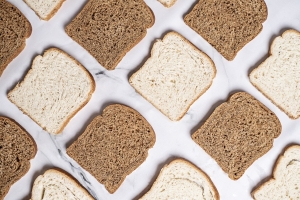Sliced Bread with Alcohol: What Does This Imply for Your Health?
Agosto 30, 2024Research conducted by the Brazilian Consumer Protection Association (Proteste) revealed surprising findings of alcohol levels exceeding legal limits in sliced breads. What does this mean for your health?
Recently, an analysis by the Brazilian Consumer Protection Association – Proteste, alarmed (and concerned) Brazilian consumers by disclosing that major brands of sliced bread in the country had alcohol levels above the permissible limit. The study, which examined 10 brands of sliced bread, found that only 4 brands had alcohol content below 0.5%, the percentage threshold to consider a product non-alcoholic.
According to Proteste, which did not disclose the details of the study's methodology, fermentation and preservatives are responsible for the alcohol in sliced bread, and a large portion of this alcohol should evaporate during the manufacturing process. The analysis raised significant concern among consumers, as some brands had alcohol levels similar to those in a 350 mL can of beer (between 2.5% and 5%).
How Does Alcohol Arise in the Production of Sliced Bread?
The ethanol present in sliced bread is not added directly as an ingredient. Instead, it forms naturally in the bread due to the fermentation process involved in the dough's rise. This occurs through fermentation with yeast – microorganisms used to leaven the bread, which consume the sugars in the dough and produce carbon dioxide (CO2) and ethanol as byproducts. The CO2 causes the dough to rise while most of the ethanol evaporates or may remain in the bread after baking. Typically, the amount of ethanol in the bread fermentation process is very low and within safe consumption limits (1).
Ethanol is also used in the preservation of sliced bread due to its antimicrobial properties (2.3). It helps prevent mold and bacteria growth, thereby extending the product's shelf life without significantly affecting the bread's flavor or texture. Ethanol is often applied as a vapor or as part of the packaging system that releases ethanol over time. However, most of the ethanol usually evaporates, leaving minimal residues in the final product (2,3).
Products classified as non-alcoholic, such as sliced bread, must not exceed the 0.5% alcohol limit set by law, even if they use additives or ingredients containing alcohol. To ensure this, industries must maintain strict quality control over their products. A product with alcohol content exceeding the legal limit may pose a risk to certain individuals, such as children, pregnant women, and people with specific health conditions like liver problems.
In response, the Brazilian Association of Biscuit, Pasta, and Industrialized Bread & Cake Industries (Abimapi) questioned the validity of Proteste's test, criticizing the methodology used and other factors that could compromise its validity, reiterating that the products are safe for consumption.
What Are the Health Impacts of Ethanol in Foods?
Several factors regarding ethanol content in sliced bread and other foods should be considered:
- Sensitivity: Some individuals may be more sensitive to ethanol, especially if they have specific medical conditions such as liver problems.
- Quantity: The ethanol present in sliced bread that adheres to legal standards is very small compared to alcoholic beverages. Therefore, consuming bread should not result in ethanol-related adverse effects.
- Alcohol Metabolism: Since alcohol is primarily metabolized by the liver, the residual amounts found in bread generally do not impact health for most people. However, due to the results of Proteste’s research, further studies are needed to assess blood alcohol concentration after consumption.
- Children and Pregnant Women: The amount of alcohol in bread meeting standards is considered harmless, even for children and pregnant women. Therefore, quality control must be stringent to detect alcohol levels exceeding the legal limit and prevent such products from reaching consumers, ensuring the safety of these groups.
Breathalyzer Test
Another concern mentioned by Proteste is the possibility that drivers could be accused of intoxication on a breathalyzer test after consuming at least 2 slices of sliced bread from some of the tested brands. However, Proteste did not conduct tests to measure blood alcohol concentration in drivers.
It is possible for a breathalyzer to give a positive (false-positive) result after eating sliced bread, as well as after consuming other products with small amounts of alcohol, such as mouthwashes or liqueur chocolates. However, due to the volatile nature of alcohol, residual alcohol is quickly eliminated within minutes. If this occurs, it is recommended to inform the traffic officer about the consumption of the product and request a retest.
It is worth noting that the breathalyzer is a device used to measure blood alcohol concentration by analyzing the air exhaled from the lungs. When someone "blows" into the breathalyzer, the device estimates the amount of alcohol in the body based on the concentration of alcohol in the exhaled air.
The Importance of Quality Control
Regular consumption of foods with residual alcohol does not have a negative impact on health for most people. However, consumers have the right to choose to avoid foods with any amount of alcohol, even if residual. Official oversight by agencies such as Anvisa and the Ministry of Agriculture, as well as quality control by qualified laboratories during production, are crucial to ensure that products not meeting legal standards do not
compromise consumer safety.
References:
- Ebrahimi, F., Khanahmadi, M., Roodpeyma, S., & Taherzadeh, M. J. (2008). Ethanol production from bread residues. Biomass and bioenergy, 32(4), 333-337.
- Jideani VA, Vogt K. Antimicrobial Packaging for Extending the Shelf Life of Bread—A Review. Critical Reviews in Food Science and Nutrition. 2015 Jan 20;56(8):1313–24.
- Latou, E., Mexis, S. F., Badeka, A. V., & Kontominas, M. G. (2010). Shelf life extension of sliced wheat bread using either an ethanol emitter or an ethanol emitter combined with an oxygen absorber as alternatives to chemical preservatives. Journal of Cereal Science, 52(3), 457-465.


